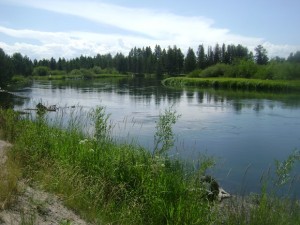Districts
Editorial: A Voice for Jefferson County
Source Weekly Published March 31, 2016

A lawsuit pertaining to the upper Deschutes River between Wickiup Reservoir and the City of Bend is ongoing. Last week, a federal judge denied the request of two major environmental groups to require immediate changes to water flow, which varies drastically with the irrigation season. The joint lawsuit, based on the federally-protected Oregon spotted frog, was filed by WaterWatch of Oregon and the Center for Biological Diversity. It names the U.S. Bureau of Reclamation and three local irrigation districts as defendants: Central Oregon Irrigation District, North Unit Irrigation District and Tumalo Irrigation District. However, there are fundamental differences between those districts and it was with good cause that Jefferson County farmers were the most concerned about the judge’s decision.
Deschutes County irrigated land is mostly used for forage and cattle. Jefferson County, on the other hand, is one of the top counties in the U.S. for seed production. In the 2012 Census of Agriculture, the average value of agricultural products sold per farm in Deschutes County was $16,033. In Jefferson County, the average was $137,198. Those who have never heard of prior appropriation are probably not at the back of the line for water rights as are the farmers in Jefferson County.
It all goes back to water law established by Congress to encourage western settlement more than a century ago. When it comes to water rights, Oregon is a prior appropriation state: First to use, first in right. The irrigation districts were originally private companies and continue to hold senior water rights established in different years and with different priority dates. Jefferson County’s North Unit Irrigation District, with its priority date in 1913, is junior to Central Oregon Irrigation District with its priority dates in 1900 and 1907. Tumalo, the third irrigation district named, has certificates with priority dates of 1900, 1905, 1907, 1913 and 1961. Water rights with a priority date through 1905 can be satisfied by live stream flow, but the rest depend on water stored in reservoirs.
Thus, even though Jefferson County farmers far out produce Deschutes County, they are the first to be shut off from water according to water law. Without changing the law, there’s not much that can be done about this, except hope for collaboration and cooperation in conserving water by all parties. Since COID’s demand is fully met during most years, it has less urgency for conservation efforts. Undoubtedly, the flood irrigation practiced by farmers served by COID and TID is to the detriment of the Jefferson County farmers, but again, there hasn’t been much impetus to change.
Farmers, environmentalists and irrigation districts have overlapping and conflicting interests. Judge Ann Aiken’s decision not to alter water flows immediately came with instructions to work together and the comment that, “Trust is hard to build.” After taking more than eight years to work on a habitat conservation plan, the defendants’ attorney noted the environmentalists have grown impatient. For now, conservation and sustainable practices may not be regulated, but responsible use and protection of our water is a choice. The Jefferson County farmers are a big part of the Central Oregon economy and deserve more collaboration and timely action to build the trust required to resolve this issue.
No immediate change to Deschutes water use
Arnold Irrigation District
As one of Oregon’s oldest irrigation districts, AID has long embraced water conservation. The District has repaired leaks in an historic metal flume, lined 1.5 miles of its main canal and laterals, piped 5.5 miles of laterals, and even eliminated 4.5 miles of old laterals. Diligent water monitoring at turnouts has provided the largest contribution to conservation. AID has reduced its average rate of diversion by approximately 25 cfs since 1997. The District was one of the first to participate in the State’s instream leasing program, and for the past decade has leased roughly 2 cfs into the Deschutes River to benefit fish and wildlife.
-
Established 1900
-
PATRONS SERVED 1,587
-
ACRES COVERED 4,300
